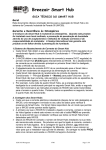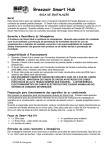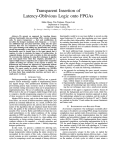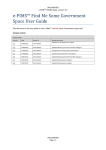Download English Business Survey: User Guide May 2013
Transcript
English Business Survey: User Guide May 2013 TNS BMRB © TNS May 2013 JN111115 Contents Introduction 3 1. What is the EBS? 3 2. What does the EBS measure? 3 3. Methodology 4 4. Strengths and Limitations 5 5. Key Points for Interpreting the Statistics 5 6. Periods covered 6 7. Accuracy 9 8. Timeliness 9 9. Revisions 10 10. Accessing the statistics 10 11. Data Availability 16 12. Feedback 16 English Business Survey User Guide May 2013 2 Introduction The purpose of this document is to help people interpret the results of the English Business Survey. It will introduce broad concepts which are important in order to understand the Statistical Releases and accompanying sets of data tables. The results have been designated as Experimental Official Statistics. This means they may be subject to revision if improvements in methodology are identified. All revisions will be pre-announced. More detailed information about the survey and its results is presented separately: information on how the questionnaire was designed is available in the English Business Survey: Report on Questionnaire Development. Whilst the English Business Survey: Technical Guide provides in-depth information on the methodology used for the survey, on how the results are compiled and on other statistical concepts related to the survey. Both of these documents, together with the Statistical Releases, accompanying tables and the English Business Survey: Questionnaire, are accessible at https://www.gov.uk/government/organisations/department-for-businessinnovation-skills/series/english-business-survey. An online reporting tool (an interactive table viewer of the English Business Survey results) has been developed to assist with dissemination of the survey results. It can be found at http://dservuk.tns-global.com/English-Business-Survey-ReportingTool/. 1. What is the EBS? The English Business Survey (the Survey) provides timely, robust and geographically detailed intelligence on business and economic conditions in England. The Survey enhances understanding of business and economic conditions throughout England and ultimately improves policy making through this understanding. The statistics are also useful to businesses, researchers and local organisations, including Local Enterprise Partnerships interested in intelligence about local economic and business conditions. Survey estimates are currently classified as experimental statistics as they are undergoing development and have not yet been assessed against the standards required for National Statistics. 2. What does the EBS measure? The Survey measures business and economic conditions at national, regional and subregional levels. Businesses are asked about their past and current experiences, as well as their expectations for future conditions. Businesses are asked about a range of topics, ranging from levels of Output and Employment to Credit conditions and Investment intentions – Figure 1 outlines the broad structure of the questionnaire and topics covered. English Business Survey User Guide May 2013 3 Topic areas covered Output Exports Domestic output Stocks Jobs and hours Prices Credit conditions Investment Capital investment Figure 1- Questionnaire Structure 3. Methodology This section provides an overview of the methods that underpin the EBS. More detail is available in the EBS Technical Guide1. The English Business Survey is a monthly telephone survey of approximately 3,000 businesses. The Survey asks managers2 simple directional questions on past, current and future business conditions, for example, asking respondents whether output is higher or lower than it was previously; this allows respondents to answer questions without the need to access detailed information. In order to reflect the relative importance or contribution of different sized workplaces to the local economy, the survey uses the number of people employed at each workplace as the measure of its contribution to the economy. To achieve this, responses are weighted so that the weighted sample matches the population with respect to sub-region and employment3. This is designed to capture the importance of the workplace to the economy; employment is used as a proxy for economic importance as a robust measure of turnover is not available for all workplaces.4 The use of employment means that the results effectively estimate the proportion of employees whose manager believes a particular measure is positive/negative/the same. 1 https://www.gov.uk/government/organisations/department-for-business-innovation-skills/series/englishbusiness-survey 2 The questionnaire script prompts interviewers to ask for the owner, manager or finance director. Interviewers are given additional job titles to ask for depending on business sizes (0-49 employees: Proprietor; 50+ employees: Site manager, Someone in the finance department, managing director, Chief Accountant) 3 The characteristics used for weighting include: location (NUTS2 Region) and employment size (12 groups: 0-1, 2, 3-4, 5-6, 7-9, 10-19, 20-49, 50-99, 100-249, 250-499, 500-999, 1000+.) More information can be found in the Technical Guide. 4 The use of employment rather than turnover to allocate the sample, is likely to be preferred even if turnover data were available, as employment is generally less volatile than turnover. English Business Survey User Guide May 2013 4 4. Strengths and Limitations This section summarises the strengths and limitations of the Survey. The Survey has a number of strengths: a large monthly sample; the ability to provide timely sub-national statistics; a workplace focus, which allows data on local conditions to be collected; an ‘economic importance’ type weighting approach to try to better represent what is happening for sub-national economies; coverage of all sectors of the economy including the public/not for profit sectors; and, timely statistics that allow policy makers and businesses to react promptly to issues. It also has some limitations: A workplace focus: collecting data at the level of the workplace means that statistics about region, employment size and industry all relate to that of the workplace, rather than for the enterprise. Accordingly, inferences about the enterprise-level business population are more limited; ‘economic importance’ weight: the process of grossing to employment totals, rather than counts, is not a traditional weighting process. This means that economic importance weights should not be used with the survey variables that ask respondents about the total number of employees5 at their site. For these variables it is more appropriate to analyse using the workplace weight. Coverage of non-registered businesses: due to the coverage of the sampling frame – the Inter-Departmental Business Register – the EBS does not cover non-registered6 businesses. This is potentially important as such businesses make up a significant proportion of the overall business population (55% of businesses) although they account for a smaller share of employment (12%) and turnover (3%)7; and, Seasonality: The statistics derived from the Survey are likely to include seasonal patterns, which have not been removed through seasonal adjustment; it is recommended that users interpret the statistics considering this fact – see time series comparison section for more information. 5. Key Points for Interpreting the Statistics This section outlines the key points that Users of the statistics should consider. Workplace Based Survey: the EBS is a survey of workplaces. A workplace can be a single business, or a workplace that is part of a larger enterprise, for example the 5 Variables that relate to total employment are qemps and qempsfl. 6 Non-registered businesses are not registered for either PAYE OR VAT, which means they are generally, the very smallest non-employing businesses. 7 Statistics on the non-registered businesses are taken from Business Population Estimates for the UK and Regions 2012 English Business Survey User Guide May 2013 5 local store of a large supermarket chain. Ninety-seven per cent of enterprises consist of a single workplace. The term business is used to describe workplaces in the Statistical Releases – for more on the different business structures, see the Technical Guide. Economic Importance (Employment) Weighting: in order to reflect the relative importance or contribution of different sized workplaces to the local economy, the survey uses the number of people employed at each workplace as the measure of its contribution to the economy. Where the size of business is reported in the Statistical Releases, it refers to the number of people employed at each workplace. Balance Statistics: balances provide a summary of the scores for businesses that expect a variable to change (generally reported as ‘higher’ or ‘lower’); and are calculated by deducting the scores for the ‘lower’ category from the scores for the ‘higher’ category. If a balance statistic is positive, more businesses experienced or expected a factor to be higher; conversely, if a balance statistic is negative more business experienced or expected a factor to be lower. Balance statistics do not provide an indication of the number of businesses that answered a factor was the same and it is recommended that users review the scores for all categories when considering a balance. Users should also be aware that a balance can be achieved through a number of different scenarios in the underlying results. For example, a balance of zero can be achieved from Higher and Lower being both 0% or both being 50%. It is therefore important to consider the underlying figures published for each variable. It is important to remember that the survey questions ask workplaces whether, for example, output was higher or lower and this does not take into account the size of any changes. Therefore a balance of 50% does not necessarily mean output growth will be higher than if the balance was 20%, as the growth rate seen by those contributing to the 20% positive balance may, in aggregate, outweigh the growth rates seen or expected by those contributing to the positive 50% balance. The difference in size between the two percentages simply means that businesses accounting for a larger proportion of the economy reported that output was higher. Time series comparisons: Data from the Survey is still in its infancy and therefore it is not yet possible to seasonally adjust the data. Users should be aware of this when interpreting the results; as it is likely that comparisons over time will show large changes for certain groups; these changes could be true changes, but they could be a result of seasonal patterns. 6. Periods covered The monthly data tables that accompany the Statistical Release relate to 15 key questions which mostly cover business and economic conditions such as output, employment, wage costs and output prices. The survey also covers capital investment, capacity constraints and a range of ad hoc questions. For more details on the questions workplaces were asked, you may refer to the English Business Survey: Questionnaire8 and the list of ad hoc questions contained in the Technical Guide. 8 https://www.gov.uk/government/organisations/department-for-business-innovation-skills/series/englishbusiness-survey English Business Survey User Guide May 2013 6 EBS Statistical Releases are labelled by the period which businesses are asked about (the main reference month). For most questions businesses are asked to compare the reference month (Month T in the diagram below) with the month three months previous and three months forward – see figure 2 for an illustration. Figure 2 – Reference Period For example, for the December 2011 EBS most backward-looking questions compare December 2011 with September 2011 and most forward looking questions compare March 2012 with December 2011. However, care should be taken, as for questions on capital investment, capacity constraints (businesses are asked whether their workforce and their capital were overstretched, used at a satisfactory level or underutilised) and annual output the question refers to a reference period of several months, not a single month. Periods being compared are clearly labelled on the monthly data tables. An overview of the periods covered is provided in Figure 3. English Business Survey User Guide May 2013 7 Fieldwork month (i) Reference month (ii) Oct-11 Backward comparison month (iii) Jul-11 Forward comparison month (iv) Jan-12 Annual backward comparison month (v) Oct-10 Backward investment period month (vi) Aug 11-Oct 11 Forward investment period month Nov 11-Jan (vii) 12 Nov-11 Dec-11 Nov-11 Aug-11 Feb-12 Nov-10 Sep 11-Nov 11 Dec 11-Feb 12 Jan-12 Dec-11 Sep-11 Mar-12 Dec-10 Oct 11-Dec 11 Jan 12-Mar 12 Feb-12 Jan-12 Oct-11 Apr-12 Jan-11 Nov 11-Jan 12 Feb 12-Apr 12 Mar-12 Feb-12 Nov-11 May-12 Feb-11 Dec 11-Feb 12 Mar 12-May 12 Apr-12 Mar-12 Dec-11 Jun-12 Mar-11 Jan 12-Mar 12 Apr 12-Jun 12 May-12 Apr-12 Jan-12 Jul-12 Apr-11 Feb 12-Apr 12 May 12-Jul 12 Jun-12 May-12 Feb-12 Aug-12 May-11 Mar 12-May 12 Jun 12-Aug 12 Jul-12 Jun-12 Mar-12 Sep-12 Jun-11 Apr 12-Jun 12 Jul 12-Sep 12 Aug-12 Jul-12 Apr-12 Oct-12 Jul-11 May 12-Jul 12 Aug 12-Oct 12 Sep-12 Aug-12 May-12 Nov-12 Aug-11 Jun 12-Aug 12 Sep 12-Nov 12 Oct-12 Sep-12 Jun-12 Dec-12 Sep-11 Jul 12-Sep 12 Oct 12-Dec 12 Nov-12 Oct-12 Jul-12 Jan-13 Oct-11 Aug 12-Oct 12 Nov 12-Jan 13 Dec-12 Nov-12 Aug-12 Feb-13 Nov-11 Sep 12-Nov 12 Dec 12-Feb 13 Jan-13 Dec-12 Sep-12 Mar-13 Dec-11 Oct 12-Dec 12 Jan 13-Mar 13 Feb-13 Jan-13 Oct-12 Apr-13 Jan-12 Nov 12-Jan 13 Feb 13-Apr 13 Figure 3 – Reference period dates Notes: i. Field work month: the month in which workplaces were surveyed. ii. Reference month: this is the month that the business compares its past and future performance with. This is asked for all questions. iii. Backward comparison month: this is a month in the recent past that the business compares its current performance to. This is asked for most (but not all questions). iv. Forward comparison month: this is a month in the near future that the business is asked how it expects its performance to compare to the reference month. v. Annual comparison month: this is 12 months prior to the reference month. The business is asked one question (qoutyr) to compare performance with the previous year. vi. Backward investment period month. This question is asked for Capital Investment questions only. Businesses are asked whether they have invested during this period. vii. Forward investment period month. This question is asked for Capital Investment questions only. Businesses are asked whether they plan to invest during this period. EBS results are also published on a quarterly basis; these quarterly statistics are created by aggregating three months of responses and using a quarterly weighting scheme. The quarterly release differs from the regular monthly Statistical Release by providing more detailed geographical information in the accompanying tables. The tables refers to business conditions in a reference quarter, see figure 4 for an illustration of the reference periods. Figure 4 Quarter reference period 7. Accuracy All estimates based on a sample of the population rather than a census are subject to sampling error. Provisional information on the likely size of these sampling errors is provided in the Technical Guide. The published tables show whether the estimate for a particular group (data is split by region, business size and industry type) is significantly different to that of England as a whole. Like all statistics, the estimates in the Survey are subject to potential non-sampling errors – for example biases; measurement errors; and calculation errors. However, attempts have been made to minimise these by, for example, rigorous testing of the questionnaires, monitoring the work of interviewers and response rates to the survey – more details on error and significance testing can be found in the Technical Guide. 8. Timeliness Statistics from the Survey are published within two months of the period to which they refer. The date of publication is announced at least four weeks in advance. Due to the experimental nature of the data the publication date for each month may vary. English Business Survey User Guide May 2013 9 However, BIS are working towards a regular publication cycle. Future publication dates will be added to the National Statistics Publication Hub9. 9. Revisions While every care has been taken to produce reliable statistics, the Survey is still being developed and has been designated an Experimental Official Statistic. As the Survey develops statistics may be subject to revision if improvements in methodology are identified. All revisions will be pre-announced where practicable and all known users notified and details summarised in the Technical Guide. 10. Accessing the statistics This section explains how to access the Statistics from the Survey and illustrates to the user how to access and interpret the statistics, using screenshots. Statistics can be found on the English Business Survey webpage10 and the EBS Reporting tool11, and are published as follows: Description Publication frequency Number of variables12 Geography available Splits Monthly Statistical Tables Monthly 15 National and Regional Business Size, Broad Industrial Sectors Quarterly Statistical Tables Quarterly 15 National, Regional and Sub Regional (NUTS213/LEP) Business Size, Broad Industrial Sectors Monthly Statistics: Reporting Tool Monthly 19 National and Regional Business Size, Broad Industrial Sectors, Enterprise type, Age of Business, Export status, Legal Status, Nationality of Ownership Quarterly Statistics: Reporting Tool Quarterly 21 National, Regional and Sub Regional (NUTS2/LEP) Business Size, Broad Industrial Sectors, Enterprise type, Age of Business, Export status, Legal Status, Nationality of Ownership 9 http://www.statistics.gov.uk/hub/index.html https://www.gov.uk/government/organisations/department-for-business-innovation-skills/series/englishbusiness-survey 11 http://dservuk.tns-global.com/English-Business-Survey-Reporting-Tool/ 12 15 of the variables in the reporting tool are the same 15 tables as reported in the monthly/quarterly statistical tables (see Figure 4). The additional variables for monthly statistics are extra questions on magnitude of change in output/expected change in output and investment (quarterly statistics on the reporting tool also include questions on exporting. 13 The nomenclature of territorial units for statistics (NUTS) classification is a hierarchical system for dividing up the economic territory of the EU. NUTS1 is a regional classification and NUTS2 is a sub-regional classification. Within the NUTS1 region of North West England are the NUTS2 sub-regions Tees Valley and Durham, and Northumberland and Tyne & Wear. 10 English Business Survey User Guide May 2013 10 Statistical Tables Overall there are two categories of tables, tables showing how businesses: perceive the current performance of their business compared to a month, three months before; and, expect the current performance of their business will compare to a month, three month’s into the future. The tables released have the 15 ‘core’ questions that are asked every month. These are shown in figure 5 (below). Figure 5 – Table of Contents Structure and format of published tables Figure 6 is an example of the layout of a typical data table. It shows the result for the QOUTPUT question on Level of business activity or volume of output in Dec-11 compared with Sep-11. The variable name on the tables is the same as used in the questionnaire and in the SPSS microdata. The Table’s title information can be found in row 7 of the worksheet. It shows the variable name and a brief explanation of the question that respondents were asked in the survey14. Row 8 shows the coverage of the question; in the table below this was all businesses that were interviewed. In the Stocks table (Figure 10), the question was only asked of those industry sectors that commonly hold stocks. 14 The questionnaire is published: questionnaire-core-questions-only English Business Survey User Guide May 2013 https://www.gov.uk/government/publications/english-business-survey- 11 Figure 6 – Example table (Qoutput) Row 12 (in Figure 6 above) shows the number of businesses who responded to the question. Results are provided at national level (column C - ‘England’), at regional level (columns D to L ‘Region (NUTS1)’), by broad size of the workplace (columns M to P ‘Workplace size’) and by broad industry sector (not seen in this screenshot but are to the right of the Workplace size results in columns Q to T). In this example, 2,995 English businesses were interviewed. Of these, 410 were located in the South West and 685 workplaces employed between 1 and 9 employees. Note that, in this table, figures by characteristics (e.g. region, workplace size and industry sector) are independent of each other. In other words the 685 businesses employing 1 to 9 employees are spread across the regions; for example, this table does not show how many businesses with 1 to 9 employees are located in the South West. Figures on this row are counts of the number of businesses that responded to the question and are rounded to the closest 5 to preserve confidentiality; knowing the number of businesses that responded to the question helps assess how reliable results are likely to be, as results based on small unweighted counts would generally be less reliable. Figure 7 – example of directional indicators English Business Survey User Guide May 2013 12 Rows 13 to 16 (in Figure 7 above) show the responses businesses could give to the question; in this example, the responses that can be given are higher, lower or the same. Looking at the ‘Higher’ row in the ‘England’ column shows that 33% of businesses felt that their business activity in December 2011 was higher than in September 2011. At the regional level, sometimes referred to as NUTS115, 31% of businesses in the East Midlands felt that their business activity in December 2011 was lower than in September 2011. Results are weighted and then percentages calculated and rounded. Due to rounding, column percentage figures may not always add up to 100%. Many of the tables which accompany the Statistical Release have the same possible response of higher, the same, or lower; however, a few do differ: Workforce and Capital Use questions: ask about whether the workforce/ capital were overstretched, used at a satisfactory level or underutilised in the reference month (for the December 2011 EBS this is December 2011), this question can be treated in a similar way to questions reporting higher/ the same/ lower. Capital investment question: ask if any capital investment has been made in a certain 3 month period (for the December 2011 EBS this is October 2011December 2011) or if there are any plans to make any capital investments in the next 3 month period (for the December 2011 EBS this is January 2012March 2012). This is a yes/ no question rather than a directional question. Figure 8 – significant differences Monthly results (for regions, workplace sizes and industry sectors) have been tested to determine whether each estimate has a statistically significant difference to the estimate for England as a whole.16 On the published tables, results that are 15 The acronym NUTS stand for Nomenclature of Territorial Units for Statistics. The digit ‘1’ indicate the level at which these statistics are, in this case the English regional level. 16 BIS are currently developing the ability to test the quarterly statistics for statistical significance. English Business Survey User Guide May 2013 13 determined to have a statistically significant difference17 from England are shaded in blue (as in figure 8). For example Figure 8 shows that 42% of businesses in Yorkshire and The Humber report output being higher in December 2011 compared to September 2011. This cell is highlighted so it indicates that 42% is significantly different from the 33% seen in England as a whole. More details on sampling errors for the EBS are available in the Technical Guide. Figure 9 – Balance statistics Balance statistic (see section 5 for more information) are usually contained in Row 17 – see Figure 8. Balance statistics are calculated by the ‘Higher’ percentage minus the ‘Lower’ percentage and are calculated on unrounded figures which are then rounded independently; as a result, some balances may not equal the difference between the ‘higher’ and ‘lower’ rounded figures in the tables. Statistical testing is not carried out on balance statistics. Figure 10 – Presentation 17 At the 95% confidence level English Business Survey User Guide May 2013 14 Figure 10 above illustrates the symbols used to indicate when a figure has been suppressed due to the small number of responses. The symbols used in the tables are: *: this indicates there were too few responses in a particular cell to produce a reliable estimate, for example, the small percentage of Don’t knows reported in the Construction sector in Figure 10. -: this indicates that there were too few responses in this particular column to produce reliable results. Figure 10 shows that the results for Education, Health and Public administration and defence sector were too few to be published – in this example this was because the stocks questions were not asked of this sector given they typically do not hold stocks. ...: indicates that the count of businesses (published in the ‘Unweighted Base’ row) was too small and the column was suppressed or that one or both of the higher/ lower % cells was suppressed so that the balance could not be calculated. For example, in Figure 10 no businesses in the Education, Health and Public administration and defence sector were asked the question on Stocks so the balance could not be calculated. All figures and percentages in the tables have been rounded. Unweighted counts have been rounded to the nearest 5 and percentages have been rounded to the nearest integer. Reporting Tool An online reporting tool has been developed to assist with dissemination of the survey results. It can be found at http://dservuk.tns-global.com/English-Business-SurveyReporting-Tool/ The online reporting tool is an interactive table viewer of the Survey results, providing more comprehensive and geographically detailed results than published in the tables that accompany the Statistical Release. The tool allows more flexible access to the Survey results, allowing users to choose the period, variable and geography of interest to produce a more tailored set of statistics. The Reporting Tool allows analysis at England, Regional level, Local Enterprise Partnership (LEP) areas and NUTS2 regions and for a combination of time periods and variables – Figure 11 provides a summary. The reporting tool is updated with the latest EBS results two days after they are published on the .GOV.uk website. English Business Survey User Guide May 2013 15 Figure 11 – Online Reporting Tool options 11. Data Availability Data tables and the statistical release are available within two months of the period that the survey refers to. EBS Micro data are also available to ‘approved researchers’ via ONS’ Virtual Micro Laboratory18 and an aggregated version of the dataset is available to academics from the UK Data Archive19. 12. Feedback For enquiries, or to give feedback on any aspect of the survey or data outputs, please use the details below: Statistician: Gary Wainman Tel: 0114 207 5114 E-mail: [email protected] Letters: 2nd Floor, 2 St Paul’s Place, 125 Norfolk Street, Sheffield, S1 2FJ 18 http://www.ons.gov.uk/ons/about-ons/who-we-are/services/vml/index.html 19 http://www.data-archive.ac.uk English Business Survey User Guide May 2013 16





























